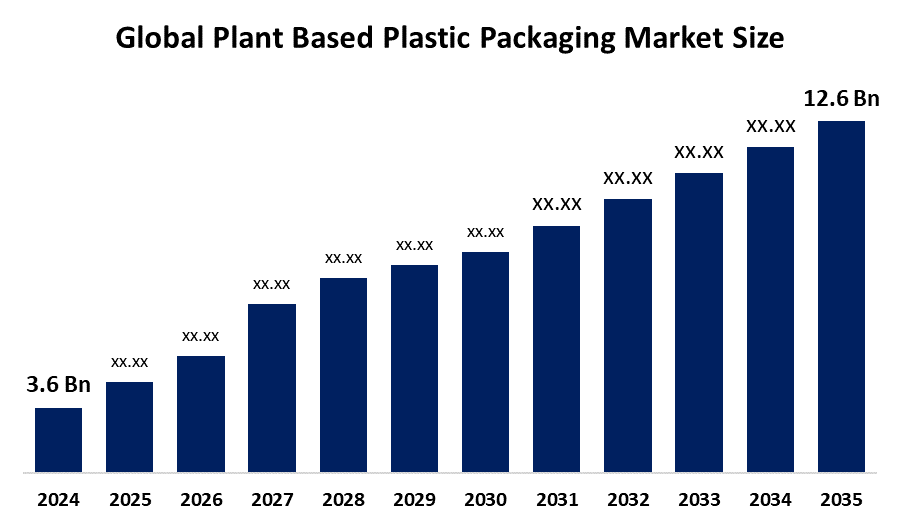
Top 10 Companies in Global Plant Based Plastic Packaging in 2025: Market Intelligence and Investment Trends (2024–2035)
RELEASE DATE: Sep 2025 Author: Spherical InsightsRequest Free Sample Speak to Analyst
Description
According to a research report published by Spherical Insights & Consulting, The Global Plant Based Plastic Packaging Market Size is projected to Grow from USD 3.6 Billion in 2024 to USD 12.6 Billion by 2035, at a CAGR of 12.06% during the forecast period 2025–2035. This strong growth can be ascribed to strict government regulations meant to reduce plastic waste as well as growing consumer awareness of environmental sustainability. The increasing need to lessen the negative effects of plastic pollution on terrestrial and marine ecosystems is driving the switch from traditional plastics to plant-based substitutes.
Introduction
The Global Plant-Based Plastic Packaging Market Size refers to the economy focused on the sourcing, development, and commercialization of plant-based packaging materials from renewable biological sources such as corn starch, sugarcane, and cellulose. This bioplastics sector aims to provide sustainable alternatives to conventional petroleum-based plastics intended to offer biodegradability, compostability, and less environmental impact. Additionally, the continuous developments in material science and biotechnology present one of the market's major opportunities for plant-based plastic packaging. To make plant-based plastics more competitive with traditional plastics, researchers and producers are always looking for new ways to improve their qualities. It is anticipated that innovations like enhancing the mechanical strength, flexibility, and durability of plant-based plastics will expand their range of applications and propel market expansion. Furthermore, it is projected that the adoption of plant-based plastic packaging will be aided by the development of cost-effective production techniques and the utilization of alternative feedstocks, such as agricultural waste, which will lower production costs.
Navigate Future Markets with Confidence: Insights from Spherical Insights LLP
The insights presented in this blog are derived from comprehensive market research conducted by Spherical Insights LLP, a trusted advisory partner to leading global enterprises. Backed by in-depth data analysis, expert forecasting, and industry-specific intelligence, our reports empower decision-makers to identify strategic growth opportunities in fast-evolving sectors. Clients seeking detailed market segmentation, competitive landscapes, regional outlooks, and future investment trends will find immense value in the full report. By leveraging our research, businesses can make informed decisions, gain a competitive edge, and stay ahead in the transition toward sustainable and profitable solutions.
Unlock exclusive market insights-Download the Brochure now and dive deeper into the future of the Plant Based Plastic Packaging Market.
Plant Based Plastic Packaging Market Size & Statistics
- The Market Size for Plant Based Plastic Packaging Was Estimated to be Worth USD 3.6 Billion in 2024.
- The Market Size is Going to Expand at a CAGR of 12.06% Between 2025 and 2035.
- The Global Plant Based Plastic Packaging Market Size is Anticipated to Reach USD 12.6 Billion by 2035.
- North America is expected to generate the highest demand during the forecast period in the Plant Based Plastic Packaging Market.
- Asia Pacific is expected to grow the fastest during the forecast period in the Plant Based Plastic Packaging Market.

Regional growth and demand
Asia Pacific is expected to grow the fastest during the forecast period in the plant based plastic packaging market. This is driven by growing consumer demand for sustainable alternatives, government regulations aimed at single-use plastics, and growing environmental consciousness. The growing food, beverage, and e-commerce industries in nations like China, India, Japan, and South Korea are driving significant growth in demand for environmentally friendly packaging solutions. The area gains from growing investments in biodegradable and compostable technologies, a rise in urbanization and disposable income, and an abundance of agricultural resources for the production of biopolymers.
North America is expected to generate the highest demand during the forecast period in the plant based plastic packaging market. This is fueled by a confluence of consumer preferences for eco-friendly products, corporate sustainability pledges, and regulatory pressure. The area gains from an established packaging sector and the growing use of bioplastics in the personal care, food, beverage, and healthcare industries. Innovation and implementation are being sped up by strict regulations aimed at single-use plastics and rising investments in recyclable and compostable materials.
Top 10 Plant Based Plastic Packaging Trends
1.Materials that are compostable and biodegradable
2.Bioplastics that can be recycled
3.Transparent and Minimalist Packaging Design
4.Ingenious and Engaging Packaging
5.Adaptable Formats for Packaging
6.Digital printing and customization
7.Seaweed and Mushroom-Based Substitutes
8.EPR Readiness and Regulatory Compliance
9.Plant-Based High-Barrier Films
10.Utilizing Models of the Circular Economy
1. Materials that are compostable and biodegradable
Rising consumer demand for environmentally friendly products and regulatory requirements, the transition to biodegradable and compostable plant-based plastics like PLA and PHA is quickening. In composting settings, these materials decompose organically, minimizing landfill accumulation and promoting circular economy objectives in the packaging of food, drink, and personal care products.
2. Bioplastics that can be recycled
A growing number of plant-based plastics are being designed to be recyclable so they can be incorporated into current waste management systems. Brands are using materials that preserve structural integrity while permitting post-consumer recovery, which promotes closed-loop recycling and lessens reliance on fossil-based polymers.
3. Transparent and Minimalist Packaging Design
Customers that care about the environment are drawn to simple, eco-friendly packaging that conveys sustainability and uses fewer materials. Since they provide product visibility and complement clean-label trends and trust-building tactics, transparent plant-based plastics are becoming more and more popular, particularly in food packaging.
4. Ingenious and Engaging Packaging
Smart features like NFC chips, RFID tags, and QR codes are being added to plant-based packaging to improve brand engagement, freshness indicators, and traceability. These technologies strengthen sustainability narratives while enhancing consumer interaction and supply chain transparency.
5. Adaptable Formats for Packaging
Plant-based plastics are being used to create lightweight, resealable, and space-efficient formats like squeeze tubes and stand-up pouches. For retail and e-commerce applications, these designs provide durability and convenience while lowering material consumption and transportation expenses.
Empower your strategic planning:
Stay informed with the latest industry insights and market trends to identify new opportunities and drive growth in the plant based plastic packaging market. To explore more in-depth trends, insights, and forecasts, please refer to our detailed report.
Top 16 Companies Leading the Plant Based Plastic Packaging Market
1.NatureWorks LLC
2.Braskem
3.BASF SE
4.Corbion N.V.
5.Danimer Scientific
6.Total Corbion PLA
7.Novamont S.p.A.
8.Biome Bioplastics Limited
9.Toray Industries, Inc.
10.Arkema Group
11.Futerro
12.Mitsubishi Chemical Holdings Corporation
13.Plantic Technologies Limited
14.Cardia Bioplastics
15.FKuR Kunststoff GmbH
16.Green Dot Bioplastics
17.Others
1. NatureWorks LLC
Headquarters - Plymouth, Minnesota, United States.
An innovative manufacturer of biopolymers, NatureWorks LLC is well-known for its IngeoTM PLA materials, which are made from yearly renewable plant sources. The business provides recyclable and compostable solutions that support global sustainability goals to a variety of industries, including packaging, textiles, nonwovens, and durable goods. Its innovations, which include coated paper applications, flexible films, and rigid containers, allow brands to lessen their environmental impact without sacrificing functionality.
2. Braskem
Headquarters - Sao Paulo, Brazil.
A multinational petrochemical company, Braskem SA (Braskem) produces and distributes chemical and plastic solutions. Manufacturing thermoplastic resins like PVC, polyethylene, and polypropylene is one of the company's primary operations. Customers in a variety of industries, such as paints and coatings, industrial and automotive components, food packaging, and home furnishings, use Braskem products. The company provides services to clients in a variety of industries, including packaging, agribusiness, retail, industrial, civil construction, and health and hygiene.
3. BASF SE
Headquarters - Ludwigshafen, Germany.
BASF SE (BASF) is a chemical company. It produces, markets, and sells chemicals, plastics, crop protection products, and performance products. Solvents, glues, surfactants, fuel additives, electronic chemicals, pigments, paints, food additives, fungicides, and herbicides are all part of its product line. Construction, wood and furniture manufacturing, agriculture, electronics and electrical, paints and coatings, automobiles, home care, nutrition, and chemicals are just a few of the industries that the company serves. Research and development is carried out by BASF in collaboration with scientists, partners, and customers worldwide. The business uses a global network of manufacturing facilities to conduct business.
4. Corbion N.V.
Headquarters - Netherlands
Corbion N.V. is a world leader in sustainable ingredient solutions, with a focus on biobased technologies, lactic acid, and its derivatives. By producing Luminy® PLA bioplastics for use in consumer goods, medical components, and food packaging, the company's joint venture, TotalEnergies Corbion, is a key player in the advancement of plant-based plastic packaging. Corbion's proficiency in fermentation and preservation technologies fosters innovation in the biochemical, biomedical, and food industries.
5. Danimer Scientific
Headquarters - Bainbridge, Georgia, United States.
A biotechnology business called Danimer Scientific focuses on creating biodegradable and compostable biopolymers as sustainable substitutes for plastics made from petroleum. Its exclusive Nodax PHA technology, which is made from renewable feedstocks, finds use in a variety of products such as films, fibers, coatings, and injection-molded goods. The company uses materials that break down in both aerobic and anaerobic environments to support sectors like consumer goods, agriculture, and food packaging.
Are you ready to discover more about the plant based plastic packaging market?
The report provides an in-depth analysis of the leading companies operating in the global plant based plastic packaging market. It includes a comparative assessment based on their product portfolios, business overviews, geographical footprint, strategic initiatives, market segment share, and SWOT analysis. Each company is profiled using a standardized format that includes:
Company Profiles
1.NatureWorks LLC
- Business Overview
- Company Snapshot
- Products Overview
- Company Market Share Analysis
- Company Coverage Portfolio
- Financial Analysis
- Recent Developments
- Merger and Acquisitions
- SWOT Analysis
2.Braskem
3.BASF SE
4.Corbion N.V.
5.Danimer Scientific
6.Total Corbion PLA
7.Novamont S.p.A.
8.Biome Bioplastics Limited
9.Toray Industries, Inc.
10.Arkema Group
11.Futerro
12.Mitsubishi Chemical Holdings Corporation
13.Plantic Technologies Limited
14.Cardia Bioplastics
15.FKuR Kunststoff GmbH
16.Green Dot Bioplastics
17.Others
Conclusion
The Market Size for Plant-Based Plastic Packaging is rapidly changing due to consumer demand for sustainability, regulatory requirements, and technological advancements. Developments in high-barrier, recyclable, and biodegradable materials are increasing the range of industries in which they can be used. North America drives demand through corporate initiatives and policy, while Asia Pacific leads in growth due to resource availability and industrial expansion. Competitive strategies are changing as a result of emerging trends like alternative feedstocks, smart packaging, and the integration of the circular economy. Businesses that make investments in scalable production and research and development are well-positioned to benefit from changing market conditions.
About the Spherical Insights & Consulting
Spherical Insights & Consulting is a market research and consulting firm which provides actionable market research study, quantitative forecasting and trends analysis provides forward-looking insight especially designed for decision makers and aids ROI.
Which is catering to different industry such as financial sectors, industrial sectors, government organizations, universities, non-profits and corporations. The company's mission is to work with businesses to achieve business objectives and maintain strategic improvements.
CONTACT US:
For More Information on Your Target Market, Please Contact Us Below:
Phone: +1 303 800 4326 (the U.S.)
Phone: +91 90289 24100 (APAC)
Email: inquiry@sphericalinsights.com, sales@sphericalinsights.com
Contact Us: https://www.sphericalinsights.com/contact-us
Need help to buy this report?